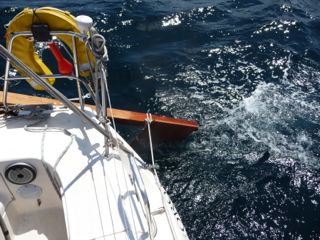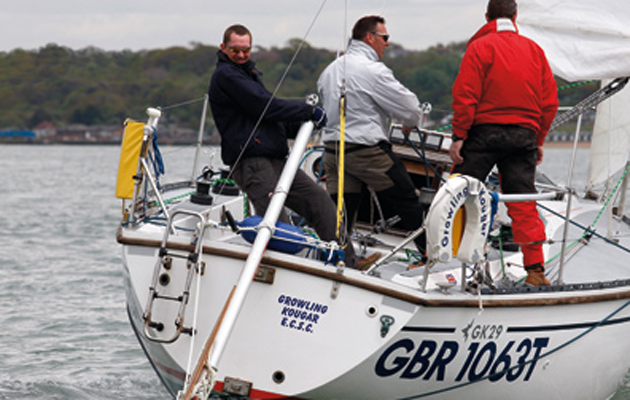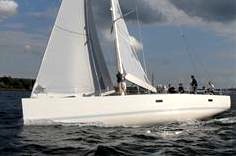The moment his beloved yacht sank in the North Sea, Julian Mustoe started thinking about ways he could avoid it happening again
‘How self steering could have saved my yacht’

Julian Mustoe, 82, completed a 10-year solo circumnavigation on his 25ft Petersen-designed Harrier of Down in 2012
The passage across the North Sea from the Shetland Islands to the Norwegian coast is slightly less than 200 miles. In early October 2015 I motored Harrier out of Symbister harbour, threaded my way through the rocks and islets south of Whalsay, and set sail for a two-day passage due east to Bergen. On the first day a southwest breeze had carried me to the halfway point, then a calm extended into the middle of the second night. Unexpectedly, the wind swung into the east and quickly rose to force 7.
Harrier is too small and light to be able to work against such a wind. I hove to, deployed my sea anchor and settled down to wait for the weather to sort itself out. In these conditions I like to secure the tiller with stout shock cord rather than rope. Shock cord helps to absorb and disperse the stresses imposed on the tiller and rudder by the tumult of the water. In the afternoon of the third day, during a survey on deck, I noticed that the tiller was strangely inactive and not straining against the shock cord.
The rudder stock aboard Harrier was a stout stainless steel rod. The top of the stock was tapered and splined. A block of stainless steel, weighing about a kilo, was drilled to fit over the tapered stock and bolted into place. The tiller was in turn bolted onto the sides of the block.
Inspection showed that the stainless block had broken into two pieces along the line of the hole taking the top of rudder stock. Within the broken block the stock was shearing violently as the rudder was buffeted by the seas. The circular section of the top of the stock could not be clamped, and it was clear that I had lost the ability to steer. This stainless lump was the last thing that I expected to fail.

For the want of a contingency steering system, I lost Harrier, my home of 13 years and the boat that had taken me around the world
I was able to get through to Shetland Coastguard. I was out of range of the Lerwick lifeboat but the Norwegian Coastguard agreed to send out a small patrol ship, the KV Bergen, to assist. I went aboard and they took Harrier in tow. I lay down in a comfortable bunk and fell into a profound sleep, secure in the knowledge that Harrier was safe in the hands of professionals. However, I was awoken with the news that Harrier was in difficulties and taking on water. From the bridge of the Bergen I had to watch her lose her tow rope and see her bow slowly sink below the surface. I felt that I was watching an old friend drown.
Harrier was a strong boat. I had lived aboard her for nearly 15 years. She had looked after me well during a 10-year circumnavigation of the world. A part of my life went down with her, and I had lost more than a boat, all because a hefty lump of stainless steel had split in half. Another time, I shall not sail without a back-up steering arrangement.
Lessons learned
Many steering problems result from a failure of the yacht’s steering linkage. A tiller breaks, a steering cable fails, or the upper end of a rudder stock comes adrift. Such failures are probably more common than the complete loss of a rudder.
Aboard Harrier, the tiller attachment failed but the rudder itself remained in working order. Before sailing I could have taken the precaution of fixing two ring bolts through the upper trailing edge of the rudder blade. Then, using her aft boarding ladder I would have been able to attach lines port and starboard to the rings, and so contrived a rough-and-ready tackle with which to steer. A similar arrangement might be improvised on wheel-steering yachts.

Scanmar makes an emergency rudder than fits onto brackets on the transom
Carrying a complete spare rudder would be a reliable precaution against complete failure. A robust emergency rudder is sold by Scanmar International of Richmond, California. Permanent hinges are fixed onto the yacht’s transom before embarkation. In an emergency, the rudder is shipped on the hinges. A similar emergency rudder is made by Windpilot in Hamburg. Alternatively, one could make or have custom made a spare rudder and fittings.

The British-made Oceansteer offers a lower cost option for emergency steering
Small yachts may carry an Oceansteer auxiliary rudder, made in Salisbury. It consists of a transom-mounted metal frame, on which mounts a submersible plastic rudder assembly that is steerable from the cockpit. It is proven in sheltered water, but I do not know how well it would work at sea.

Like Cape Horn and Fleming, the Monitor windvane can ship an emergency rudder
Cape Horn windvane gear, made in Oka, Canada, can be fitted with a separate emergency rudder and tiller that can be shipped onto the windvane’s framework. Likewise, Monitor windvane steering gear, made by Scanmar, and Fleming gear, made in Summerville, Australia, can also ship a separate emergency rudder onto their windvane gear framework.

Hydrovane is one of the self-steering systems that uses an auxiliary rudder to steer
The Auto-Helm windvane steering gear, also made by Scanmar, steers using a secondary rudder, with the yacht’s main rudder locked on a steady course. The secondary rudder can be operated by tiller rather than the vane, and so can steer the yacht in an emergency. Hydrovane windvane gear, made in Vancouver, and Windpilot both offer a similar facility.
It is possible to steer a disabled yacht downwind by trailing one or more drogues deployed astern or biased onto a quarter. Remarkable voyages have been rescued from disaster using this technique. Some kind of emergency rudder could, it has been said, be fashioned from a locker lid fixed to a spinnaker pole and deployed aft in the manner of a sculling oar. It just might function for a while in light wind and smooth water, but I think that such an arrangement would be unworkable in any serious weather. It is hard to see this serving for very long in a seaway.
Enjoyed reading this?
A subscription to Yachting Monthly magazine costs around 40% less than the cover price.
Print and digital editions are available through Magazines Direct – where you can also find the latest deals.
YM is packed with information to help you get the most from your time on the water.
- Take your seamanship to the next level with tips, advice and skills from our experts
- Impartial in-depth reviews of the latest yachts and equipment
- Cruising guides to help you reach those dream destinations
Follow us on Facebook, Twitter and Instagram.
Jury Steering
How would you get back to safety if your rudder was carried away? Chris Beeson tests three jury steering techniques…
Sailing without a rudder
Yachting Monthly took a rudderless GK29 and tried 3 different ways of steering her. See which ones worked the best.
ARC yacht loses rudder
German 53-footer towed to safety 36 hours after start








